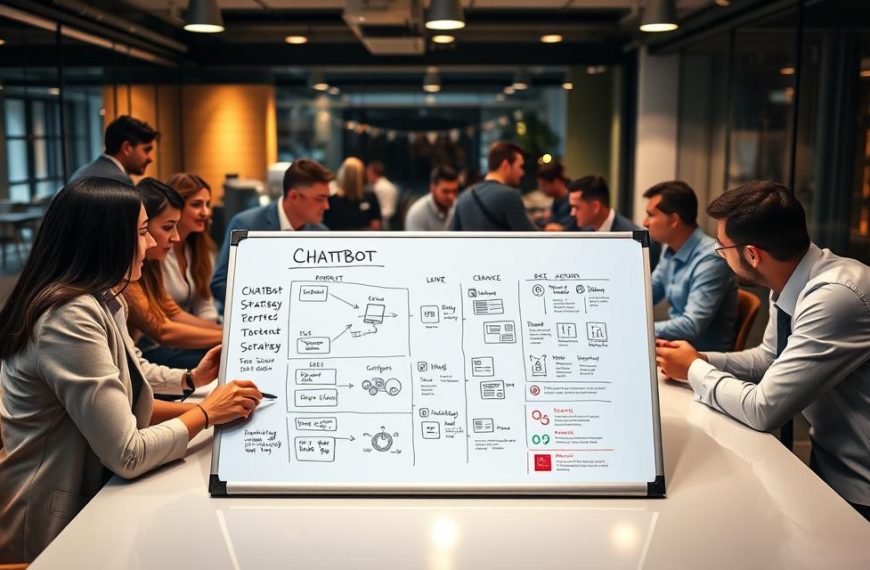In today’s fast-paced digital world, businesses are increasingly turning to artificial intelligence to enhance their operations. One of the most impactful tools is the chatbot, which leverages machine learning and conversation flow to transform customer service. According to an IBM study, 85% of executives expect generative AI to interact directly with customers within the next two years.
Enterprise-grade chatbots are designed to automate self-service tasks, providing instant responses to customer inquiries. This not only improves user experiences but also reduces operational costs. For instance, chatbots can handle up to 30-50% of routine queries, freeing up human agents for more complex issues.
Healthcare organizations have seen significant benefits, with some reporting a 40% reduction in call center volume after implementing chatbots. Additionally, IBM’s case studies show that AI-powered virtual agents can resolve queries 65% faster, enhancing efficiency and customer satisfaction.
By acting as 24/7 brand ambassadors, chatbots ensure consistent and reliable support, making them a strategic investment for businesses aiming to stay competitive. To learn more about the advantages of chatbots, visit IBM’s insights.
Introduction to Chatbots: A Strategic Move for Businesses
The rise of AI has transformed how companies interact with customers. One of the most significant advancements is the chatbot, an AI-powered conversational interface designed to automate business processes. These tools have evolved from simple rule-based systems to sophisticated platforms capable of delivering seamless user experiences.
What is a Chatbot?
A chatbot is a software application that simulates human conversation through text or voice interactions. Early versions, like ELIZA in the 1960s, relied on rigid decision trees. Today, modern chatbots leverage machine learning and natural language processing (NLP) to understand and respond to user queries with remarkable accuracy.
The Evolution of Chatbot Technology
The journey of chatbot development has been marked by significant milestones. In 2001, SmarterChild introduced instant messaging bots, paving the way for interactive communication. Fast forward to 2023, and generative AI models like ChatGPT can create original content, moving beyond pre-written responses.
Large language models have enabled chatbots to achieve human-like dialogue capabilities. For example, IBM’s watsonx boasts a 92% intent recognition accuracy. In healthcare, chatbots have progressed from FAQ bots to advanced symptom checkers, showcasing the technical progression of this technology.
Why Build a Chatbot: Key Benefits for Your Business
Businesses are leveraging AI-driven tools to redefine customer engagement. Chatbots, powered by artificial intelligence, offer significant advantages that can transform operations and drive growth. From improving customer service to reducing operational costs, these tools are becoming essential for modern enterprises.
Enhancing Customer Service with 24/7 Availability
One of the standout features of chatbots is their ability to provide round-the-clock support. Unlike human agents, they don’t require breaks or shifts. This ensures that customers receive instant responses, regardless of the time of day.
According to Salesforce, 64% of users prefer chatbots for quick answers. For example, healthcare organizations have seen chatbots handle 82% of routine prescription refill requests, significantly reducing wait times.
Reducing Operational Costs Through Automation
Automation is a game-changer for businesses looking to cut expenses. Chatbots can handle repetitive tasks, such as answering FAQs or processing orders, without human intervention. This not only saves time but also reduces labor costs.
IBM reports that chatbots can lower customer service expenses by 30%. A case study revealed that a 500-agent contact center saved $4 million annually by implementing chatbot solutions.
Improving User Experience with Personalized Interactions
Modern chatbots go beyond generic responses. They use data analytics to deliver tailored recommendations, creating a more engaging user experience. For instance, e-commerce platforms have seen a 23% increase in conversions through personalized product suggestions.
Healthcare chatbots also demonstrate this capability, offering cost-effective solutions. The average cost per interaction is $28, compared to $42 for human agents.
“Chatbots are not just tools; they are strategic assets that enhance efficiency and customer satisfaction.”
| Metric | Chatbot Performance | Human Agent Performance |
|---|---|---|
| Response Time | 2 seconds | 10 minutes |
| Cost per Interaction | $28 | $42 |
| Handling Capacity | Unlimited | Limited by shifts |
Types of Chatbots: Choosing the Right One for Your Business
Selecting the right chatbot solution can significantly impact your business outcomes. With various platforms and models available, understanding the differences is essential for making informed decisions. Whether you need a simple rule-based system or an advanced AI-powered tool, the choice depends on your specific goals and budget.
Rule-Based Chatbots vs. AI-Powered Chatbots
Rule-based chatbots operate on predefined decision trees. They are cost-effective, with development costs ranging from $10K to $15K. However, their capabilities are limited to specific scenarios, making them ideal for straightforward tasks like FAQs.
In contrast, AI-powered chatbots leverage language models and neural networks to understand and respond to complex queries. These solutions are more expensive, often exceeding $80K, but offer greater flexibility and accuracy. For instance, GPT-4 chatbots achieve an 89% customer satisfaction rate, compared to 67% for rule-based systems.
Generative AI Chatbots: The Future of Conversational AI
Generative AI chatbots represent the next evolution in conversational technology. These solutions can create original responses, making them highly effective for industries like healthcare and finance. For example, they have reduced mortgage approval times by 40% in financial services.
In retail, Sephora’s chatbot handles 70% of color match queries, showcasing its efficiency. However, businesses must consider compliance needs, such as HIPAA certification in healthcare, when selecting a chatbot.
“The right chatbot can transform customer interactions, driving efficiency and satisfaction.”
| Feature | Rule-Based Chatbots | AI-Powered Chatbots |
|---|---|---|
| Cost | $10K-$15K | $80K+ |
| Customer Satisfaction | 67% | 89% |
| Flexibility | Limited | High |
Integrating Chatbots into Your Business Operations
Effective chatbot integration can revolutionize how businesses operate and interact with customers. By seamlessly connecting with existing systems, these tools enhance efficiency and streamline workflows. Whether it’s automating tasks or improving customer interactions, the right integration strategy is key to maximizing chatbot potential.
Seamless Integration with Existing Systems
Chatbots thrive when they integrate smoothly with enterprise platforms. For example, API connections with tools like SAP enable real-time data exchange, reducing manual effort. In healthcare, Epic EHR integration has cut patient intake time by 30%, showcasing the power of well-executed integrations.
Middleware plays a crucial role in ensuring compatibility with legacy systems. This approach allows businesses to modernize without overhauling their entire infrastructure. For instance, a retail company used middleware to connect its chatbot with an outdated inventory system, achieving a 40% reduction in stock discrepancies.
Chatbots in CRM: Streamlining Customer Interactions
Integrating chatbots with CRM solutions like Salesforce or Zendesk can transform customer service. These tools handle routine inquiries, freeing up agents for complex issues. A contact center using Zendesk with a chatbot reported handling 200% more tickets, significantly improving efficiency.
CRM analytics dashboards capture chatbot-driven lead data, providing actionable insights. For example, a sales team used chatbot data to identify high-potential leads, resulting in a 25% increase in conversions. This demonstrates how chatbots enhance both operational and strategic capabilities.
- API integration with enterprise platforms ensures seamless data flow.
- Middleware bridges the gap between chatbots and legacy systems.
- CRM solutions combined with chatbots boost ticket handling and lead generation.
Cost Considerations: How Much Does It Cost to Build a Chatbot?
Understanding the financial investment required for chatbot development is crucial for businesses planning to adopt this technology. Costs can vary widely based on features, platforms, and the level of expertise involved. A transparent budgeting approach ensures you allocate resources effectively.
Factors Influencing Chatbot Development Costs
Several factors impact the overall expense of creating a chatbot. The complexity of the solution, such as whether it’s a basic FAQ bot or an advanced EHR-integrated assistant, plays a significant role. For example, healthcare chatbots can range from $50K to $150K+, depending on their capabilities.
Deployment methods also affect costs. Cloud-based solutions often reduce upfront expenses, while on-premise setups may require higher initial investments. Additionally, staffing choices—whether you use an in-house team or hire an agency—can influence the budget significantly.
Cost-Effective Strategies for Chatbot Development
To minimize expenses, consider modular development. Phased implementation can save up to 35% by allowing you to prioritize essential features first. Pre-trained models are another cost-saving option, reducing development time by 40%.
Open-source tools like Rasa offer affordable alternatives to enterprise platforms like IBM Watson. These solutions provide flexibility and scalability without the high price tag. By carefully evaluating your needs, you can create a chatbot that fits your budget while delivering value.
| Chatbot Type | Estimated Cost | Key Features |
|---|---|---|
| Basic FAQ Bot | $15K | Simple responses, limited integration |
| EHR-Integrated Medical Assistant | $120K | Advanced healthcare functionalities, seamless integration |
| AI-Powered E-Commerce Bot | $80K | Personalized recommendations, 24/7 support |
Chatbots and Artificial Intelligence: The Role of Machine Learning
The integration of advanced technologies like machine learning and NLP has redefined how chatbots operate. These tools enable chatbots to understand, process, and respond to user queries with remarkable accuracy. By leveraging artificial intelligence, businesses can create conversational agents that deliver seamless user experiences.
Natural Language Processing (NLP) in Chatbots
NLP is the backbone of modern chatbot technology. It allows chatbots to interpret human language and generate contextually relevant responses. Transformer models, for instance, process 60% more context than traditional RNNs, enhancing their ability to handle complex queries.
IBM’s NLP solutions achieve 95% accuracy in medical terminology recognition, showcasing its potential in healthcare. Attention mechanisms in transformer architectures further improve understanding by focusing on key parts of a conversation. This ensures chatbots deliver precise and meaningful interactions.
How AI Enhances Chatbot Capabilities
AI-powered chatbots use supervised and unsupervised learning approaches to improve over time. Supervised learning relies on labeled data, while unsupervised learning identifies patterns independently. Both methods contribute to continuous learning workflows, validated through human-in-the-loop processes.
For example, Mayo Clinic’s multilingual medical bot supports both Spanish and English, demonstrating the versatility of AI-driven solutions. These advancements highlight how artificial intelligence enhances chatbot capabilities, making them indispensable for modern businesses.
Chatbots in Different Industries: Real-World Applications
Across industries, chatbots are reshaping how businesses address customer needs and streamline operations. These AI-powered tools are not just limited to customer service; they are solving industry-specific challenges and driving measurable results.
Healthcare: Streamlining Patient Interactions
In healthcare, chatbots are revolutionizing patient care. They handle routine tasks like appointment scheduling, reducing no-show rates by 27%. Post-operative monitoring chatbots have also been effective in lowering hospital readmissions by providing timely reminders and tracking recovery progress.
For example, a chatbot integrated with EHR systems can send medication reminders and answer common queries. This not only improves patient outcomes but also reduces the workload on medical staff, allowing them to focus on critical cases.
E-commerce: Boosting Sales and Customer Engagement
E-commerce platforms are leveraging chatbots to enhance customer engagement and drive sales. AI-powered product recommendations have led to a 19% increase in conversion rates. Sephora’s chatbot, for instance, boosted makeover appointments by 11%, showcasing the potential of personalized interactions.
Chatbots also handle order tracking and returns, providing seamless support throughout the shopping journey. This ensures customers receive timely assistance, fostering loyalty and repeat business.
Other Industry Applications
Chatbots are making waves in other sectors as well. In banking, compliance chatbots have reduced fraud investigation time significantly. Manufacturing companies use parts ordering bots to cut procurement time, while insurance firms accelerate claims processing through document AI.
| Industry | Chatbot Application | Impact |
|---|---|---|
| Healthcare | Appointment scheduling, post-op monitoring | 27% reduction in no-show rates |
| E-commerce | Product recommendations, order tracking | 19% increase in conversions |
| Banking | Fraud investigation, compliance | Reduced processing time |
Overcoming Challenges in Chatbot Development
Developing chatbots comes with its own set of challenges, especially when ensuring data security and addressing limitations. Businesses must navigate these hurdles to create effective and reliable conversational tools.
Ensuring Data Security and Privacy
One of the top concerns for enterprises is data leakage, with 68% citing it as a significant risk. To mitigate this, robust encryption protocols are essential. For instance, HIPAA-compliant chatbots require AES-256 encryption to protect sensitive information.
In healthcare, protecting Protected Health Information (PHI) is critical. Chatbots must follow strict protocols, such as multi-layered approval workflows for sensitive transactions. This ensures that only authorized personnel can access or modify data.
Compliance with regulations like GDPR and CCPA is also crucial. While GDPR focuses on user consent and data minimization, CCPA emphasizes transparency and consumer rights. Businesses must tailor their chatbot features to meet these varying needs.
Addressing Limitations of Traditional Chatbots
Traditional chatbots often struggle with accuracy and flexibility. For example, earlier models had hallucination rates as high as 22%, leading to incorrect or irrelevant responses. Modern solutions like GPT-4 have reduced this to 8%, significantly improving reliability.
Another limitation is the inability to handle complex queries. Rule-based systems, while cost-effective, are restricted to predefined scenarios. AI-powered models, on the other hand, can understand and respond to nuanced questions, making them more versatile.
Financial services have implemented audit trails to address these issues. This ensures that every transaction is logged and traceable, enhancing accountability and trust. By adopting advanced features, businesses can overcome the limitations of traditional chatbots and deliver better user experiences.
- Implement AES-256 encryption for HIPAA compliance.
- Use multi-layered workflows for sensitive transactions.
- Compare GDPR and CCPA requirements for global operations.
- Leverage modern models like GPT-4 to reduce errors.
- Adopt audit trails for financial services to ensure transparency.
Future Trends in Chatbot Technology
The future of chatbot technology is evolving rapidly, driven by advancements in artificial intelligence. Businesses are increasingly adopting these tools to enhance efficiency and improve customer experiences. According to Gartner, 40% of enterprises will use chatbot-driven process automation by 2026, signaling a significant shift in how industries operate.
One of the most exciting developments is the rise of multimodal chatbots. These capabilities combine text, voice, and video interactions, offering a more immersive user experience. For example, healthcare providers are exploring ambient clinical documentation bots that transcribe patient-doctor conversations in real time, reducing administrative burdens.
The Rise of Generative AI Chatbots
Generative AI is transforming chatbot technology by enabling more natural and context-aware conversations. Unlike traditional systems, these tools can create original responses, making them ideal for industries like healthcare and finance. For instance, AI therapists with emotional intelligence are emerging, providing mental health support with unprecedented accuracy.
In manufacturing, AR-equipped bots are assisting technicians by overlaying instructions directly onto equipment. This not only improves efficiency but also reduces errors. Quantum computing is another frontier, with the potential to enable real-time language translation, breaking down communication barriers globally.
How Chatbots Will Shape the Future of Business
Chatbots are set to redefine business operations across sectors. In healthcare, they are streamlining patient interactions and reducing administrative workloads. In e-commerce, personalized recommendations are driving higher conversion rates. The impact on labor markets is also significant, with 30% of customer service roles expected to evolve as automation becomes more prevalent.
These advancements highlight the growing importance of chatbots as strategic tools for businesses. By leveraging generative AI and multimodal capabilities, companies can stay ahead in a competitive landscape.
| Trend | Potential Impact |
|---|---|
| Multimodal Chatbots | Enhanced user experiences through text, voice, and video interactions |
| Generative AI | More natural and context-aware conversations |
| Quantum Computing | Real-time language translation for global communication |
Best Practices for Building a Successful Chatbot
Creating a successful chatbot requires a strategic approach and attention to detail. By focusing on clear objectives and rigorous testing, businesses can ensure their chatbot delivers exceptional value. Below are actionable guidelines to help your team navigate the development process effectively.
Defining Clear Objectives for Your Chatbot
Start by outlining SMART goals for your chatbot project. Specific, Measurable, Achievable, Relevant, and Time-bound objectives ensure clarity and focus. For example, a healthcare chatbot might aim to reduce appointment no-show rates by 20% within six months.
Align your chatbot’s needs with your business goals. Whether it’s improving customer service or streamlining operations, a well-defined purpose drives success. Chatbots with clear KPIs achieve 73% higher user satisfaction, making goal-setting a critical step.
Testing and Iterating for Optimal Performance
Testing is essential to refine your chatbot’s functionality. In healthcare, implement a protocol that includes HIPAA audits and patient safety checks. This ensures compliance while maintaining high standards of care.
Use A/B testing to evaluate different approaches. This method has been shown to improve conversion rates by 18-26%. For financial services, create a compliance checklist to address regulatory requirements during testing.
Establish a continuous improvement cycle. Weekly model retraining ensures your chatbot stays updated with the latest data. Incorporate a user feedback loop with sentiment analysis to identify areas for enhancement.
“A well-tested chatbot is not just a tool; it’s a dynamic solution that evolves with user needs.”
- Outline SMART goals to guide your chatbot project.
- Conduct HIPAA audits and safety checks for healthcare chatbots.
- Use A/B testing to optimize performance and conversion rates.
- Implement weekly retraining to keep your chatbot current.
- Leverage sentiment analysis to gather actionable user feedback.
Conclusion: Why Building a Chatbot is Essential for Modern Businesses
Adopting advanced conversational tools is no longer optional for enterprises aiming to stay competitive. Early adopters report a 3.5x ROI within 18 months, while 92% of businesses plan to expand their usage. These solutions drive cost savings, improve customer satisfaction, and boost revenue significantly.
For example, a healthcare case study revealed a 300% ROI from a chronic care management bot. With 68% of competitors already deploying these tools, delaying implementation risks falling behind. A phased approach ensures seamless integration and maximizes impact.
Start by defining clear objectives, testing rigorously, and iterating for optimal performance. Begin your development journey today to secure your place in the future of business innovation.
















